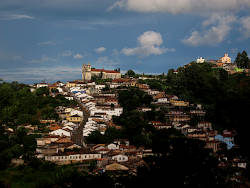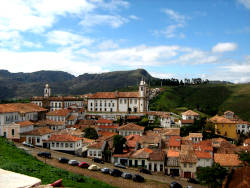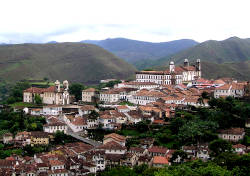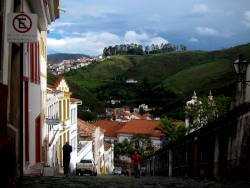Ouro Prêto




Minas Gerais is world-famous among mineral collectors because the majority of all semi-precious stones are mined in this state. The state of Minas Gerais produces about 80% of Brazil’s precious gems and minerals. Ouro Prêto (Black Gold) is the mining center of the state, originally for gold, first discovered around 1700. The caused the Brazilian Gold Rush which resulted in 800 tons of gold sent to Portugal during the 18th century. Later gemstones, especially diamonds, emeralds and topaz were discovered. Less attractive for jewelry are amethyst and tourmaline (NaFe+++3Al6(BO3)3Si6O21F), which are mined in huge quantities and huge sizes.
The tourist mines in Minas Gerais are historic, interesting and exciting but don’t take along your friendly mine inspector or tell your insurance company too much! While the gold mines were located inside the borders of the city, the gemstone mines cover an area of about 20 square miles around the city. The city itself is today listed in the UNESCO World Heritage List for its wealth of historic buildings of the gold rush era. The whole city lives in its own history, a small colonial town, looking like a historic Portuguese town.
Ouro Prêto sits right on an outcrop of banded iron formation. This formation is a sedimentary rock with many layers of iron ore, often altered to iron oxide especially ochre. There are also copper deposits, which sometimes are transformed to malachite. The dark rocks were the reason for its name Ouro Prêto which means black gold as a reference to the dark colour of the local gold, which contains a lot of iron oxides. However, the gold is mostly bound to gold bearing quartz veins, not to the iron. As far as we know, the iron is not mined.
The underground beneath the city is full of mine passages, there are kilometers of old passage, many are collapsed. Several parts of this enormous system are prepared for tourists and allow a close insight into the mining history. The city currently lists eight show caves [2022], we have some more but guess some have closed. Ouro Prêto has a mining school (Escola de Minas) with some tradition and a fantastic mining museum with an excellent mineralogical exhibition.
Today the area around Ouro Prêto is famous for its topaz (Al2SiO4(F,OH)2). In fact, all pink topaz and most of the peach-coloured so-called imperial topaz mined in Brazil originates from an area less than 20 kilometers around Ouro Prêto. Hydrothermal lodes contain many minerals, among them quartz, hematite, magnetite, and accessory rutile, pyrite, and euclase. The enclosing rock was once schist or marble, but it eroded under tropic climate conditions to lateritic clay. This chemical process does not harm the resistant gemstones despite its aggressive chemistry, so they can be found in a good condition in the soft sediments.
| 1711 | city founded as Vila Rica (rich city). |
| 1735 | topaz discovered. |
| 1768 | Portuguese government officially recognizes the commercial gem deposit. |
| 1823 | renamed Ouro Prêto. |




 Mina 13 de Maio
Mina 13 de Maio Antonio Pereira Imperial Topaz Mine
Antonio Pereira Imperial Topaz Mine Mina do Bijoca
Mina do Bijoca Capão Mine
Capão Mine Minas Chico Rei
Minas Chico Rei Mina Felipe dos Santos
Mina Felipe dos Santos Minas Fonte Meu Bem Querer
Minas Fonte Meu Bem Querer Mina do Jeje
Mina do Jeje Virgem da Lapa
Virgem da Lapa Museu de Minas Ouro Prêto
Museu de Minas Ouro Prêto Minas Do Palácio Velho
Minas Do Palácio Velho Minas de Passagem
Minas de Passagem Mina de Ouro Santa Rita
Mina de Ouro Santa Rita Minas Velha
Minas Velha Mina du Veloso
Mina du Veloso Mina Vila Rica
Mina Vila Rica
 Search DuckDuckGo for "Ouro Preto"
Search DuckDuckGo for "Ouro Preto" Ouro Prêto - Wikipedia
Ouro Prêto - Wikipedia MINAS DE OURO
MINAS DE OURO  (visited: 26-APR-2022)
(visited: 26-APR-2022) Index
Index Topics
Topics Hierarchical
Hierarchical Countries
Countries Maps
Maps